One of the Most Valuable Chord Types
You'll Ever Learn...
![]()
In the first week of this class (week 8), we learned about major 6th chords. They are 4-note chords -- the root, 3rd, 5th -- just like a major chord, but you also add the 6th degree of the scale to the major triad. The 6th is ALWAYS one whole step above the 5th -- never a half step -- so they are real easy to find. Then we changed those major 6th chords into minor 6th chords just by altering the 3rd 1/2 step -- in other words, a minor triad with a 6th on top.
Today we're going to take up 7th chords-- very important chords, because they move you from one tonal base to another tonal base. In other words, when we move from the C chord to the F chord, we often use C7 between the two as a "connector." Actually, there are two types of 7th chords -- a 7th, which we're considering today, and a major 7th, which we will take up next time.
To form a 7th chord, just find the 7th note of the scale and lower it 1/2 step. (Next week we'll take up the "Major 7th" chord, which uses the scale 7th.) But with a plain 7th chord, we lower the 7th 1/2 step. Just add the lowered 7th note of the scale -- not the 7th -- the lowered 7th -- to the major triad. So here is the formula for a 7th chord:
A 7th Chord = Root - 3rd - 5th - flat7th
Here's what 7th chords look like on the staff: (Remember that accidentals carry over in each measure!)
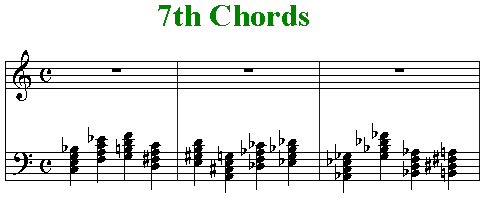
Musical Suggestion -- You can achieve a "cleaner," less thick chord sound by omitting the 5th degree of any seventh chord, whether or not the chord symbol indicates the omitted 5th, e.g. C7 (omit 5). This practice is a matter of personal taste. On the PSR-2000, if you omit the 5th, the chord is still recognized as a 7th. Play C-E-G-Bb or C - E - Bb and the PSR-2000 assumes you are playing C7. - JW
And here's what they look like on the staff when played with the left hand: (They appear in the same order as before:)
 |
 |

|
 |
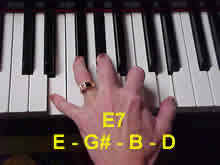 |

|
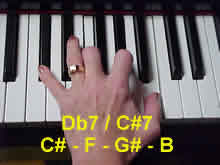 |
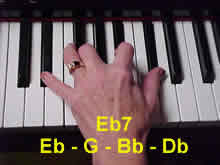 |
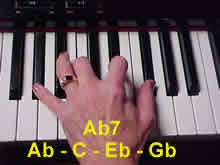
|
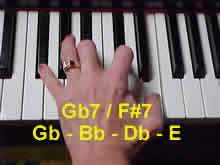 |
 |
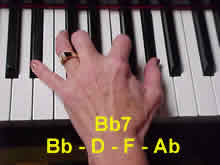
|
7th chords want to move up a perfect 4th -- they don't have to, but that is their tendency. So if you encounter a G7 chord, what is the next likely chord? Sure -- a C chord. Why? Because it's a 4th higher than G. If you encountered an Eb7 chord, what is the most likely chord to follow it? Right. Ab. Why? Because Ab is a 4th above Eb. Just knowing that gives you a tiny idea of how much you can gain from knowing chord progressions, which we will take up as soon as we get through learning all the chords.
As usual, now it's up to you. Play each 7th chord in root position, then 1st inversion, then 2nd inversion, then in 3rd inversion (the 7th will be the lowest note of the chord.) Play each chord up and down the keyboard for at least 2 octaves -- maybe 3 octaves. Play them with your left hand, then play them with your right hand. Then play them hands together. Exercises Go through all 12 major chords , inverting every one. Then go through all the 12 minor chords, inverting each one up and down the keyboard -- hands alone, then hands together. Then go through all 12 diminished chords, inverting each one up and down the keyboard -- each hand alone, then together. Then play the 12 augmented chords, up and down the keyboard. Then skip around from major to minor to diminished to augmented, etc.
Then add minor 6th chords to your repertoire of chords. They are shown in root position above, but you know that you can turn them upside down 'till the cows come home -- invert them -- so go to it!
And then add 7th chords and their inversions....
Do you feel like you're getting a handle on chords yet? You ought to -- I know we're going slowly, but chords are SO important that you absolutely MUST master them if you are ever going to play the piano or your keyboard like you hope to!
So here's our revised chord scorecard:
12 major + 12 minor + 12 diminished +
12 augmented + 12 major 6th + 12 minor 6th + 12 7th chords
make 96 chords and 3 or 4 inversions of each
mean you can now play
Over 300 chords!
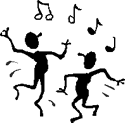 Yea!
Gimme a high five!
Yea!
Gimme a high five!
In the next lesson we will add 12 more chords to our growing list of chords we can play by adding major 7th chords to our stash. (Actually 48 more chords, since each 4-note chord such as a 7th can be inverted 4 ways -- root position, 1st inversion, 2nd inversion, and 3rd inversion.)

